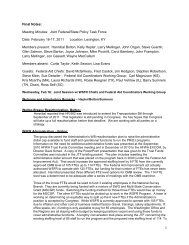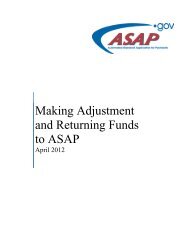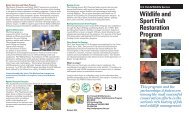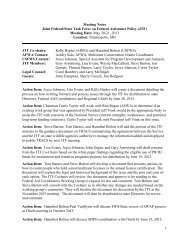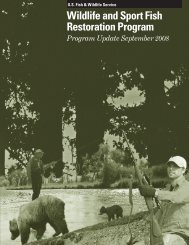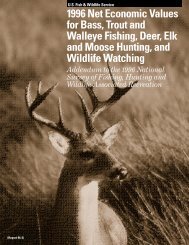Financial Returns To Industry From The Federal Aid - Wildlife and ...
Financial Returns To Industry From The Federal Aid - Wildlife and ...
Financial Returns To Industry From The Federal Aid - Wildlife and ...
You also want an ePaper? Increase the reach of your titles
YUMPU automatically turns print PDFs into web optimized ePapers that Google loves.
Some projects may have a negative ROI to the industry, but a positive<br />
ROI to the economy <strong>and</strong> the sport in general. Such projects offer value by<br />
providing the knowledge needed to develop new hunting opportunities in the<br />
future, or access to new hunting l<strong>and</strong>s. Efforts funded by the excise tax have<br />
helped defend our right to hunt by upholding modern scientific management of<br />
wildlife in the face of legal challenges seeking to end various hunts.<br />
In constant (2009) dollar terms, consumer purchases of tax-related hunting <strong>and</strong><br />
shooting equipment at the retail level over the period ranged between a low of $2.8<br />
billion in 1970 to $5.2 billion in 1996 (in 2009 dollars), while excise tax collections<br />
ranged between a low of $177 million in 1984 to a high of $324 million in 1994 (in 2009<br />
dollars).<br />
Several important factors significantly leverage the power of excise-tax dollars paid by<br />
industry:<br />
By law, excise tax dollars spent by state wildlife agencies must be<br />
matched by at least 25% of outside funds; in reality this match is much greater<br />
because numerous other funding sources also contribute to wildlife restoration<br />
efforts. <strong>The</strong> impact of these funds is an inherent “return” to industry since<br />
many of these projects would not likely have been conducted without the core<br />
funding provided by excise taxes.<br />
Investment in conservation <strong>and</strong> access projects is long-term <strong>and</strong> builds off<br />
of investments by previous generations. For example, l<strong>and</strong> <strong>and</strong> water access<br />
purchased now will benefit hunters <strong>and</strong> industry for generations to come.<br />
Thus, some of the financial returns attributable to any given year may have<br />
been sown through investments made in preceding years or decades.<br />
While the financial attributes of the excise tax that were the focus of this analysis are<br />
paramount to individual companies, several other aspects of the <strong>Wildlife</strong> Restoration<br />
Program also have implications for a company‟s long-term financial health, including:<br />
Prior to passage of the <strong>Wildlife</strong> Restoration Act, state license fees paid by<br />
hunters were often diverted for purposes not related to hunting, such as<br />
supporting public schools.<br />
Now, prior to receiving any excise tax dollars, states must certify that their<br />
hunter-license dollars are only used for administration of fish or wildlife<br />
programs, thus protecting those state-license revenues for programs<br />
benefiting hunting <strong>and</strong> their supporting industries.<br />
Every year since 1938, the amount of hunter-license dollars protected has<br />
exceeded the amount of excise taxes paid by manufacturers by as much as<br />
1,000%, thus vastly increasing the purchasing power of industry‟s investment.<br />
By federal law, hunting excise-tax monies must be appropriated by<br />
Congress for their intended use <strong>and</strong> cannot be diverted or held up for other<br />
purposes. An act of Congress <strong>and</strong> agreement by the President would be<br />
required to change this.




